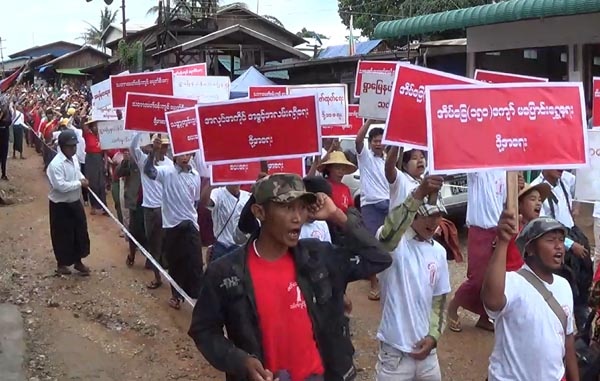Over 1,000 in Mandalay Protest Mining Activities
Originally appeared in Democratic Voice of Burma
September 1, 2014 The mining sector in Burma continues to receive flak, with protestors taking to the streets in Wetthay and Phetshay villages in Thabeikkyin, Mandalay.
The mining sector in Burma continues to receive flak, with protestors taking to the streets in Wetthay and Phetshay villages in Thabeikkyin, Mandalay.
On 30 August, the villagers protested against the encroaching mining activities on village land and the displacement of more than 150 households. Aimed at gold mining companies such as Myanmar Golden Pwint, Shwe Pyi Thar and Htarwarra, along with other metal mining companies in the region, the protestors condemned the breaching of boundary lines by these companies and expanding mining activities onto legally recognized village land.
The Ministry of Home Affairs legally recognised Wethay and Phetshay, along with 22 other areas, as villages on 20 January 2010, “restricting mining activities in these regions.”
Local resistance and protests are increasing with the mining industry steadily acquiring a notorious reputation for neglecting and not adhering to agreements. Earlier in May, Yamethin Township witnessed a protest over the Moehti Moemi mines, regarding the arrest of 10 miners.
The rally witnessed a clash between security forces and protestors, who expressed dissent against the mining activities that they said, were “illegal, with damaging consequences to the environment in the vicinity.” The adverse effects of gold mining in Mandalay are widespread, with serious occupational hazards such as “drillers disease” on the rise .
The protest also stems in the face of the Burmese government overlooking the detrimental side of the mining industry. A report published by EarthRights International sheds light on the policy loophole that continues to exist in the mining sector in Burma.
View the original article here.
Tags: EarthRights International, Government of Myanmar, Mandalay Region, Mining, Ministry of Home Affairs, ProtestThis post is in: People's Voices
Related PostsTwo New Briefers Expose Failings with Myanmar’s First Special Economic Zone
Analysis of the Affected Communities’ Rights and Remedies Under Myanmar Law and JICA’s Guidelines
Analysis of EIA for Phase I of Thilawa SEZ
First U.S. Companies Release Reports on Investments in Myanmar
“There is No Benefit, They Destroyed our Farmland”









 All posts
All posts